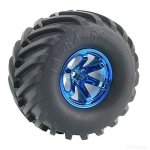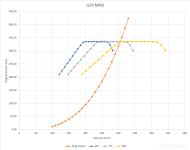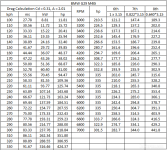>
You are using an out of date browser. It may not display this or other websites correctly.
You should upgrade or use an alternative browser.
You should upgrade or use an alternative browser.
Forum's Z4s top speed listing
- Thread starter B21
- Start date
Mr Tidy said:Taking it all with a pinch of salt as it's just a bit of theoretical fun, but still interesting.
But as I put 45 section rear tyres on my MC the rev-limiter wouldn't cut in at 172mph in fifth, so maybe 177mph would be possible? The only certainty is that I won't be testing the theory - I'd miss my driving licence. :lol:
If your OE tyres were 225/40 then yes 177 mph in 5th would be the result :driving:
B21 said:If your OE tyres were 225/40 then yes 177 mph in 5th would be the result
My OE rear tyres would have been 255/40 x 18 but I got 255/45 x 18 fitted for a bit more sidewall now I'm getting on a bit!
Mr Tidy said:B21 said:If your OE tyres were 225/40 then yes 177 mph in 5th would be the result
My OE rear tyres would have been 255/40 x 18 but I got 255/45 x 18 fitted for a bit more sidewall now I'm getting on a bit!
Well all you are getting is 177mph come what may … :driving:
B21 said:Well all you are getting is 177mph come what may …
I'm sure that is never going to be a problem.
But I can't help wondering what my E90 N-52 engined 330i might manage. :rofl:
axelleveau
Member
sars said:Correct, torque at the wheels will reduce as you go from first to second, then second to third etcetera, however you still go faster every time you change up. The reason being that as long as there is torque then there is force and as mass doesn’t change you accelerate and go fasteraxelleveau said:I am sorry but I have to disagree... As you shift your engine torque will go up but the torque at the wheels will go down as the gearing has changed
Wrong, because power is a function of torque and rpm, the equation is Power = torque x rpm/5,252. Engine torque peaks at x rpm and reduces there after as rpm increases, but power rises with increasing rpm (max torque is achieved at a lower rpm than max power). As you change up engine rpm drops for the same speed and thus engine torque is higher than before you changed gear. What you struggling to grasp is regardless of what gear you are in the power at the wheel is matched at engine rpm, i.e. at say 2000 rpm at the engine, the power at the wheel is exactly the same in second as it is in sixth.axelleveau said:As long as power in 6th at the RPM you'll end up at after the shift is lower than power in 5th at the RPM you were before the shift you'll end up slowing down :roll:
OK, I get this might be hard to imagine without graphs so here is how things actually happen. I quickly set up an Excel with data found online for an N52 and E86 and made the aero give me a top speed of 250kph at top of 5th. As we can see, if you shift from 5th to 6th, the Tq as well as power at wheel falls and it will not recover from there as your speed will drop and settle to lower value. This is a usual behavior for cars where the ratios are made for effciency/cruising or at least have an overdrive gear to do so. Most of the cars I work on have an 8/9 speed auto but will be at Vmax in 6th/7th and will simply not shift into higher gear with a 100% throttle input.
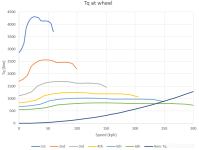
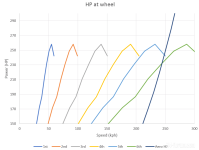
sars said:A couple of things, [ref]B21[/ref], I know you’ve estimated some losses from crank to wheel, did you take BMW efficient dynamics into account, that is there’s potentially very little losses, those from transmission and diff (going to be less than a kW), as everything else runs off the battery, which only charges when you’re decelerating.
[ref]buzyg[/ref], Physics, the power available at the crank or wheels, is the only thing the governs maximum velocity as long as the final drive gearing and maximum engine rpm allows, gear ratios and thus torque at the wheels governs the time it takes to get to V-max.
SARS I'm fine with physics. :wink: Your over simplifying things though. Or rather you are not accounting for BHP VS Velocity in a given gear. The Z4M is geared for 201 mph in 6th gear. So you need to plot the power curve with mph along the x axis. and look how much power is available at a given speed, then put that power figure into your equation. At 175mph the power is less than it would be if the car could reach 195mph. You will need a simultaneous equation to work out where the sweet spot on the curve is. Enjoy. I always hated those things. Or you could just try figures for various speeds until you find the sweet spot.
Edit: Read Axelleveau's post after I wrote the above. He has explained what I am wittering on about nicely with those graphs.
If adding too speeds and Powers....
Socketr 35i(s) tuned to 420bhp 10 years ago,
Cars still on here although can't remember the current owner.
So that should be at 3rd place surely, unless you want to pick and choose what cars go down on the list,lol
Also Dave1971s last E89 35i was modified to 380bhp and is still on here with its current owner
Likewise sammyz e89 35i also at 380bhp.
Not got any print outs,but doesn't make it less so.
Socketr 35i(s) tuned to 420bhp 10 years ago,
Cars still on here although can't remember the current owner.
So that should be at 3rd place surely, unless you want to pick and choose what cars go down on the list,lol
Also Dave1971s last E89 35i was modified to 380bhp and is still on here with its current owner
Likewise sammyz e89 35i also at 380bhp.
Not got any print outs,but doesn't make it less so.
It's a good job it's a wet day!
[ref]axelleveau[/ref], [ref]buzyg[/ref], I do understand what you are both saying and I am sure that automobile design engineers indeed choose to over gear transmissions to facilitate better fuel economy and reduce emissions especially with automatic transmissions, thank you for the pretty graphs, they did help explain what you were trying to say
However, the graphs looked wrong and I couldn't put my finger on why, so I spent the wet morning completing my own using the engine power which is readily available and accurate, as every engine is tested after assembly to confirm minimum performance characteristics. What both graphs below demonstrate is why gear spacing is important and why engineers spend a lot of time getting it right, because of the effect on driving experience.
My original response to [ref]buzyg[/ref], was "as the final drive gearing and maximum engine rpm allows" and I concede that I should have also stated as long as the power available in any gear exceeds the power needed to overcome drag. Though if you look at both charts, one for the e86 3.0si and the other for buzyg's e85 z4m, they clearly show as power starts to drop off, power in the next gear is not significantly less and importantly, behind the drag power curve and thus Vmax is in 6th. And yes they don't include transmission losses but they will be identical for 5th and 6th gears. I have not chosen to perform this using power at the wheel, because there is no provenance on the dyno results and they would be specific to that car only.
When I first helped B21 with the calculations, the theory behind was to give an estimate of the Vmax on all the Z4's, using principles of power and drag equations, which he has expanded on, the idea was not to plot out every power in gear curves oke:
oke:
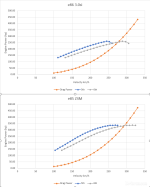
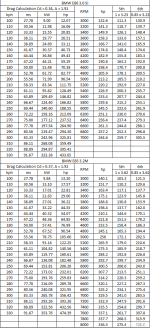
power data taken from automobile-catalogue and Cd taken from carfolio
[ref]axelleveau[/ref], [ref]buzyg[/ref], I do understand what you are both saying and I am sure that automobile design engineers indeed choose to over gear transmissions to facilitate better fuel economy and reduce emissions especially with automatic transmissions, thank you for the pretty graphs, they did help explain what you were trying to say
However, the graphs looked wrong and I couldn't put my finger on why, so I spent the wet morning completing my own using the engine power which is readily available and accurate, as every engine is tested after assembly to confirm minimum performance characteristics. What both graphs below demonstrate is why gear spacing is important and why engineers spend a lot of time getting it right, because of the effect on driving experience.
My original response to [ref]buzyg[/ref], was "as the final drive gearing and maximum engine rpm allows" and I concede that I should have also stated as long as the power available in any gear exceeds the power needed to overcome drag. Though if you look at both charts, one for the e86 3.0si and the other for buzyg's e85 z4m, they clearly show as power starts to drop off, power in the next gear is not significantly less and importantly, behind the drag power curve and thus Vmax is in 6th. And yes they don't include transmission losses but they will be identical for 5th and 6th gears. I have not chosen to perform this using power at the wheel, because there is no provenance on the dyno results and they would be specific to that car only.
When I first helped B21 with the calculations, the theory behind was to give an estimate of the Vmax on all the Z4's, using principles of power and drag equations, which he has expanded on, the idea was not to plot out every power in gear curves


power data taken from automobile-catalogue and Cd taken from carfolio
sars said:Another graph this time of the M40i, oh my the B58 is just so peachy, no wonder you can get more out of it as they artificially control torque to keep a flat power band restricted to 335 hp :x
Screenshot 2022-02-21 180019.png
Screenshot 2022-02-21 180059.png
Yes lots of potential there…MHD cites 420bhp without hardware mods and 450 with just some very basic mods..way to go :driving: :rofl:
